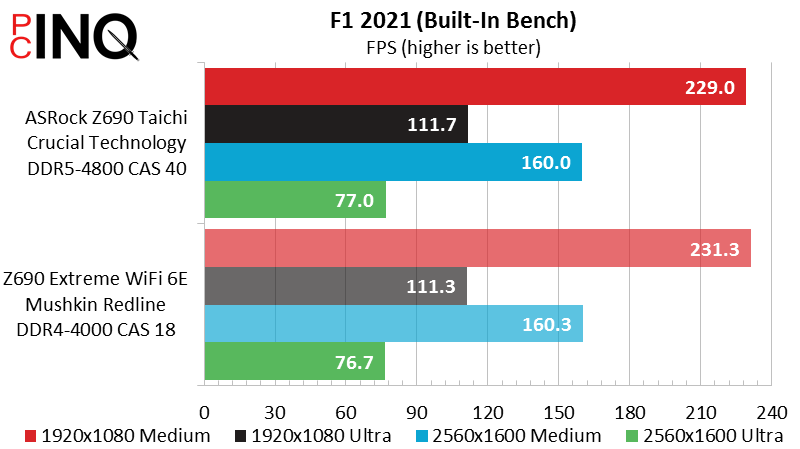Feature Packed & OC Friendly: ASRock Z690 Taichi Review
Installation, Evaluation & Conclusion
Contents
Though it might not appear fair at first blush, Crucial’s DDR5-4800 picks up where Mushkin’s DDR4-4000 left off. Those who can’t figure out why we didn’t use our previously reviewed Mushkin DDR4-4400 sample instead need only look at our DDR4-4000 review to see that it’s all about Intel’s Gear 1 memory controller ratio.

You may not want to see the benchmark configuration chart from page 3 of our previous review, but we’ve added that link just in case you do.




Sandra Memory Bandwidth leans into latency a bit much, while its Latency test does so even more, making DDR4-4000 appear superior. Meanwhile, AIDA64’s bandwidth measurement appears almost unhampered by latency, handing 1 out of 4 wins to the Taichi’s use of DDR5.





The Z690 Taichi and Extreme WiFi 6E swap places throughout 3DMark and PCMark, again hinting at whether each specific test benefits more from DDR4’s lower latency or DDR5’s higher bandwidth.

We’ve done extensive testing under F1 2021 and found that even while it does shift with memory performance, it basically caps out at DDR4-4000. Our graphics card probably becomes the bottleneck at that point, but 230 FPS is a pretty great place to bottleneck.




Our previous DDR5-4800 review revealed a bandwidth bent in 7-Zip that we never knew could be this severe, though we suspect that the way DDR5 ranks are configured might have something to do with that. It’s the rare benchmark where DDR5 really stands apart!


The Z690 has a few more features and draws a few more watts than the Extreme WiFi 6E, but its integration of single voltage regulator fan on the rear MOSFET heatsink at least keeps those parts a little cooler. And that’s without adding the extra fan, which we stated was included but probably not necessary in a well-ventilated case. We left it off for these tests!


With our 7-Zip test favoring DDR5 by nearly 10% and our App Startup test favoring DDR4 by nearly 5%, the Z690 Taichi came out less than 1% ahead of its DDR4 sibling in overall performance. A loss in overall efficiency is most likely due to its inclusion of a few extra features. Moreover, a look back at specific tests shows that CPU and GPU performance is on par for both platforms in applications where bandwidth-v-latency isn’t an issue.
|
Pros: |
Cons: |
|
|
|
The Verdict: |
|
|
The Z690 Taichi pleases us in every imaginable way but one: Between the external USB port mounted internally and the seventh SATA port, it appears to have given up two lanes that might otherwise have been used for the third M.2 slot (see update below). Its overall feature set is competitive with the Asus ROG Maximus Z690 Hero, and the Taichi costs around $20 less. |
|
December 1 Update: A quick look at one of the documents we discovered in May for our June 1st disclosure provided us a nugget that most review sites have overlooked: The Z690 Chipset has only 38 HSIO lanes to distribute as USB 3.x, PCIe or SATA. ASRock squeezes its 40 interfaces into the chipset’s 38 HSIO allotment by routing its two front-panel USB 3.1 headers through the ASM1074 hub mentioned in our features table. We’d like to thank ASRock for not sacrificing higher-bandwidth interfaces to achieve this as so many of its competitors have, even though we had to figure this out on our own.



2 comments
Hi. You write „ as a single PCIe 5.0 x16 pathway, or as two PCIe 5.0 x8 pathways“. My question would be, where and how did you set this up in Bios? There is no such function??? 🙁
The sixteen pathways are shared between the first and second slot. If you add a card to the second slot, it takes away eight of the first slot’s sixteen pathways.